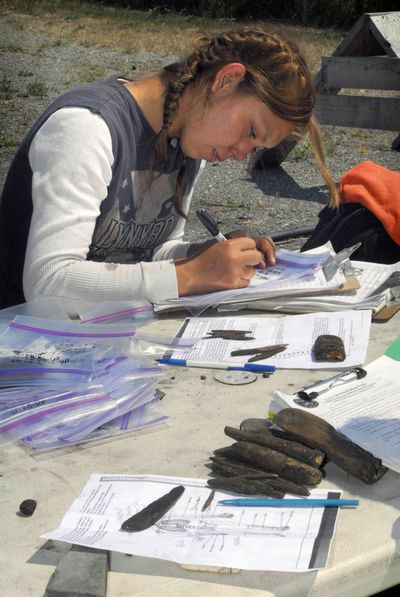Artifacts provide poignant lessons

PORT ANGELES, Wash. – For Lower Elwha Klallam tribal members working at the site of their ancestral village of Tse-whit-zen, the memory of unearthing 335 intact burials in 2003 and 2004 is fresh in their minds.
And five years later, finding bones or bone fragments at the site doesn’t get much easier.
The tribe began using a mechanical sifter last month to search for artifacts and bone fragments, known as isolates, in piles of soil dug up during construction of what was to be a state Department of Transportation “graving yard” – a large dry-dock facility. Since then, bones have been found daily, but no intact burials.
The burials are believed to have been broken apart during more than 100 years of industrial activity, including the construction of the graving yard, which was intended to build replacement components for renovation of the Hood Canal Bridge.
Construction of the graving yard was abandoned in December 2004 after the intact burials and 64,793 artifacts were uncovered.
The Hood Canal Bridge work was transferred to a graving yard in Tacoma and was finally completed in June.
“I know they get frustrated at times,” said Lower Elwha Klallam Chairwoman Frances Charles, referring to the eight tribal workers at the site who are still finding the isolates. “They don’t like seeing some of the things that we are witnessing from the past.”
Carmen Watson-Charles, 28, said she and other tribal members working at the site are always saddened when bones are found.
“I just quiet myself so I’m present for that ancestor’s human remains there. We have to learn to be present for that ancestor.”
Watson-Charles said that finding bones or their fragments is easier, emotionally, than finding intact skeletons, which happened often during construction of the graving yard.
“I had to do a lot of healing, spiritually, emotionally, physically, to not carry that sadness, because we’re not supposed to carry that kind of sadness with us,” she said.
Charles said isolates will be reburied in cedar boxes. The artifacts will be displayed in a museum planned for the property.
So far, the museum lacks a design, and the tribe needs more funding to begin construction.
The tribe received $2.5 million from the Department of Transportation in a settlement, but those funds fall short, Charles said.
Charles said the museum will be an educational tool for the tribe and the rest of the public, a place that tells “the story of what happened here.”
Once work on the site is complete and there are no more artifacts to catalog, Watson-Charles said she will continue to teach the story of Tse-whit-zen.
“It’s bitter the way it is happening,” she said. “And it’s sweet because we get all these teachings back to us.”